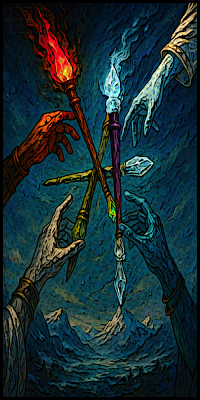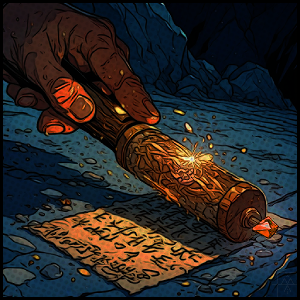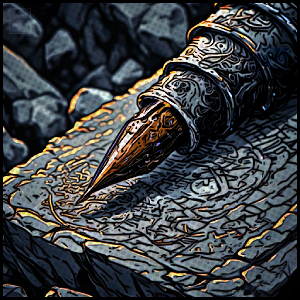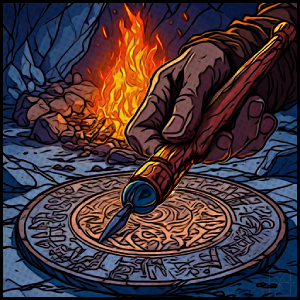Soder, Runes & Scrolls
... chisel or nail, it's an ancient tool that carves rocks into Runes.
"If you are serious about learning the secret of Words, I suggest starting with simple Leyman's Words. The Root of Origin begins here. Once you understand a few root Words, we can begin channeling those into your Work. Now, let's begin with "Fire". This cave is chilly, yes?"
Origin & Mythos
Ice Runes
The Soder traces its origins to the Sijinn of Izeiqor, where the Talasi Water Tribes carved the first Ice Runes. Written in an attempt to capture the initial magic Words of their emergent Thalsen Script, the Talasi presented their Runes to the Sijinn. When asked how such enchanted letters had been achieved, the Talasi referred to a bone-handled tool tipped in magical Ice. Other Sijinn began shaping their versions of Runes from their own artistic Soders.
Elemental Soders
Bone, Stone & Wood Runes
The Ornosi Earth Tribe were the second to innovate Rune-Craft. Bone, stone, or wood were common materials for a Soder, but Ornosi famously used huge mallets. In producing the Orren Script, Ornosi discovered that gemstones could be used in place of magical Ice. A young artisan kept breaking their tools in an attempt to write the perfect message to captivate a love interest. Unable to consider the perfect Word, the artisan smashed the stone they had been seated upon, only to reveal the first Gemstone Rune. Large mallets fell out of use due to the artisans' failed attempts initially, which led to an incredibly detailed, ornate runic script.Obsidian Runes
The Ashasi Fire Tribes developed a practice of using obsidian-tipped Soders after a myth of a young Ashasi who climbed into a volcano with a copper rod and returned with the Obsidian Runes.Miasma Runes
The Rihusi Wind Tribe formed their Runes lastly, but their legend involved a flute-like tool and dust, freezing the words mid-air, creating unique Miasma Runes. Found used in Rihusi songs and poetry.Naming the Soder
"It is not recorded the one who named the Word, but among them, it was thus known: 'Sonder'. Even in four languages, Words could be shared by Sijinn."
Soders were shaped by both the materials of the World and the meaning they carved. Magical Ice and Gemstone Soders became common among the Sijinn, prized for their affinity with certain Runes. Bone and Copper, though rarer, gained Ritual significance. Across Cultures and regions, the core form remained a humble but sacred tool.
Notable Figures & Legends
Inventor of the Soder
Though much isn't known, the person credited through Divination and myth as the creator of the Soder was Aunale' of Talasi. While the Sijinn pursued the shape of Runes, Aunale' preferred different tools than the common implements of the Time. Instead, she isolated herself in a cavern of ice, where she crafted her Soder unwittingly with a piece of Magical Blue Ice. Legends claim that Aunale's specific Blue Ice Soder is capable of restoring broken Ice Artifacts or Relics. It went on to shape the intial letters and syllables of the Talasi language, carved in Ice Runes.
Design & Function
Basic Soder
Shaped from simple, durable materials, the Soder's form reflects the Soul of its Artisan. Some are hollowed to ease channeling; others tightly bound to steady focus. The shaft itself is cosmetic. Some Cultures continued to use it as a chiseling tool with a mallet while others developed precise Soders, capable of engraving through the Soder's own enchantments.Advanced Soder
There are many variations on the common Soder. Some can be rolled along fabric while others contain multiple Runes for enchanting dense materials. Wide chisel-shapes were favored for wood and sculpting cold clay while precision tips and nails created elegant scripts.Rune and Scroll-Craft
Even without a Caster's intent, the Soder found itself applied as a literary device. With ink or dyes, Soders were utilized as crude pens for Scroll-Craft. Yet this same process was also used in crafting magical and mundane Runes. As a writing utensil, the mundane Soder found common use, but its ritual purposes kept the enchanted Runic Soders within tight circles. Object Enchantment
Soders craft magical Runes into items, such as gear, armor, tools, and weapons. By combining one or multiple Runes within an object, a new type of item is created. This woven pattern of Runes is called a Spell Matrix. Once inscribed, the matrix becomes a permanent part of the object.Mechanics & Inner Workings
With the ability to harness and channel potential Source, a Soder effectively draws out the Source of components associated with the desired Rune, Word, or outcome, and embeds their residual energies into an object. The Soder binds and tethers the energies from resources used in item or Spell-Craft. When consuming raw materials, their pure energies coalesce as the materials diminish, consumed. Drawing the glyph accurately while containing the residual Source energies and Word meaning strengthens Casters.When crafting or enchanting objects, Soders: "Draw", "Engrave", "Imbue", and "Scribe".
Craft & Manufacture
Crafting a Basic Soder
TTRPG- Crafting
Proficiency:- Tool Craft (Spirit)
- Cost: TBD Casho
- DV: 5/+1 per 2 Hours
- Consumes Components
Time to Craft: 3-4 Hours
Ash Soders
Ashasi Ash Soders are rolled across fabric or wood to leave small burns in the shape of their Ashen Script. Crafted using sacred ash and bone and tipped with topaz, an Ash Soder left important messages or recorded important myths of the Ashasi Tribes. Ceremonial in nature, Ash Soders were popular story-telling devices. The gemstone tip of this unique Soder increases with heat; when in use, the Soder warms as it channels or enchants with Fire Source. 
Scorch-Mark Runes
Cultural Versions & Variations
Aelven Soders
Aelven Stylus
The migrant Aelves of Izeiqor brought the initial enchanted Soders to distant lands, but the Aelves adapted the Aelven Stylus- a style that favored a narrow, chiseled tip. Often contained a hollow compartment to allow for enchanted properties, the Stylus never fell out of popularity with the Aelves and their kin. Aelven Stylus were used with dye to make cloth or painted Scrolls. The Aelven Stylus lost the ability to carve or engrave upon objects.Root-Born Runes
In an attempt to mimic the Wordcaps, where many of their magical Words derived, the Aelves created a type of Stylus known as a Rooted Stylus. With one associated Word, this enchanted Soder can place a Rune inside the seed of fruit-bearing trees. Once the seeds sprout, the enchanted Word can be found on the fruit or the roots. The Rooted Stylus only works on the plant that it's carved from. Aelven Artisans often used the same Soders. Folk Soders
Mystic Chisels
The Myst Folk of Isaleir were known for adapting the Soder after trading with traveling Sijinn Pilgrims. Their Soders were based off of the old Ornosi design, which includes a large mallet. This actually worked well in carving Runes into their vessels and shelters. These types of Runes were distinct from their language, but informed much of Isaleirian Culture. Found on trail markers, Mystic Runes navigated coasts and glaciers by marking Folk Stones.Mythic Chisels
As story-tellers, the Myth Folk were intrigued by the Soders, and created tools called Mythic Chisels. The Myth Folk favored a set of varying tools, mainly formed from old antlers or horns. This allowed the Myth Folk to create a range of expressions within their letters and grids. This featured in their Cultural work, as clay pots began to feature additional properties. Using the chisel, Mythic Totems were also figures of fable, speaking with stone mouths in phrases known to the Folk.Rune Fang
Among the Buniru and Proto-Human Tribes, the ancient carving tools were not as useful as the Rune Fangs. Thought to be interpretations of the Soder, Rune Fang were often literally the fang or nail of a creature that had been inscribed with Words sacred to these Cultures. This tool sometimes became a weapon as well, like a primitive dagger. Rune Fangs carried potent enchantments meant for battle.
Legacy & Historical Significance
Access & Distribution
WIP- TBD
Arx- Core D10 System TTRPG information is currently WIP. Thank you for your patience! Evolution & Technological Innovation
Scrivener of the Modern Age
Runic Chisels

Soder
Availability
Ritual, Uncommon
Region:
Global
Demographic:
Multicultural
TBD Casho
Fabricate

File or Chisel
Tuning Fork
Wood, Stone, Bone, or Metal (Shaft)
M. Ice, Gems, Relic Bone (Nib, Source)
Resin, Cord, or Sinew (Bindings)
Technology
Aunale' of Talasi
Invented first Soder and Ice Runes.
Izeiqor
IA / 2nd Era
Bone, wood, or stone handle tipped in Magic Ice; infused by Caster's Source.
Stylus (Aelven)
Rune Fang (Buniru, P-Human)
Aelven Stylus
Ash Soders (Ashasi)
Ice Soders (Talasi)
Fluted Soders (Rihusi)
Gemstone Soders (Ornosi)
Mystic/ Mythic Chisels (Folk)
References
Mentioned Articles
Ethnicity
Myth
Arc Sagas' universe and the Arx-Core D10's System (TTRPG) are © Myth-X, 2023–2025. AI assets generated via perchance.org or Elara-AI; all AI Images edited, watermarked by Myth-X. Iconography sourced from RPG-Awesome or Font Awesome. Content is hosted and displayed via World Anvil.
All rights reserved. Redistribution or commercial use without express permission is prohibited.






Hi there! A neat way to expand on the magic of runes by including different methods of scripting. I enjoyed working through your article and selected it for inclusion in my 2025 Summer Camp Reading Challenge article. Feel free to read more at
2025 Summer Camp Reading Challenge
WIP - The Chaos Bringer: A Dark Fantasy BG3 FF
"Thou dost not meddle in the affairs of dragons, lest thou be chewed in self-defense..."
Thank you for including my work with your Reading Challenge! I want you to know that I appreciate the substantial feedback you've provided. I also appreciate the time you spent reading Soder, and with your feedback, I'll polish this and other Articles like it. Thank you!
I really enjoyed the article, rune are always a fascinating subject and paired with magic makes them even better. The system you created is intriguing, and I'm glad that my feedback had made a positive contribution!
WIP - The Chaos Bringer: A Dark Fantasy BG3 FF
"Thou dost not meddle in the affairs of dragons, lest thou be chewed in self-defense..."
I have to agree. You mentioned in your Reading Challenge forms of Runes, and I do wish to confirm that the base inspiration is there. I thought it might be interesting to know that when it comes to the Aelven / Elvish forms of Runes and script, I imagine they had a practice similar to Ogham, in that it was typically done on wood in vertical alignments for Divinatory or Ritual practice. Small details, but I think stuff like this adds up, and builds a very nice picture in the end. Words and the forming of Phrases will feature heavy in Arc Sagas' mechanics as a TTRPG, so something like this checks many World-Building boxes, imo. And yes, absolutely! I believe I'll shift the Historical information up in Technology Articles moving forward. That was a good call; it makes more sense in these kinds of Articles, where the History is more the subject than craft or design. Arc Sagas is an evolving, innovating process, and it's not without support like this that I can improve on the design. Thanks again, for being a reader and for including AS in your Summer reading! I'm sincerely and super happy you enjoyed!
♪(〜^∇^ )〜
WIP - The Chaos Bringer: A Dark Fantasy BG3 FF
"Thou dost not meddle in the affairs of dragons, lest thou be chewed in self-defense..."